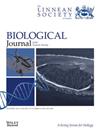地方性多形蜗牛inrella ampulla的系统地理格局受地理因素的支配。
IF 1.5
3区 生物学
Q3 EVOLUTIONARY BIOLOGY
引用次数: 0
摘要
一个物种内部的遗传多样性可以由气候和地理等非生物因素塑造。我们的目的是确定这两个非生物因素对inrella ampulla的相对重要性,inrella ampulla是一种来自印度西高止山脉的单型蜗牛,有三种颜色变化,有一些重叠分布。我们还想研究这些颜色变化是否代表不同的谱系或早期物种。对32只壶腹水蚤的1个核基因和2个线粒体基因进行了测序。我们使用系统发育、种群遗传和生态位建模工具来解决这些问题。结果表明,颜色形态不是相互的单系,并表现出相当大的生态位重叠,表明它们不能被认为是早期物种。此外,研究结果还表明,古气候振荡对该物种遗传多样性的影响还不能确定。在某种程度上,帕尔伽特峡谷似乎塑造了这一群体的遗传多样性。分布在Palghat Gap南部的颜色形态没有混合,与其他形态的生态位重叠最少。景观的地理位置似乎在塑造该物种的遗传多样性方面发挥了突出作用。本文章由计算机程序翻译,如有差异,请以英文原文为准。
Phylogeographical patterns are governed by geography in endemic polymorphic snail Indrella ampulla (Gastropoda: Ariophantidae)
Genetic diversity within a species can be shaped by abiotic factors, such as climate and geography. We aimed to ascertain the relative importance of these two abiotic factors to Indrella ampulla, a monotypic snail species from the Western Ghats, India, that has three colour morphs with some overlapping distributions. We also wanted to investigate whether these colour morphs represent divergent lineages or incipient species. We sequenced one nuclear and two mitochondrial genes from 32 individuals of I. ampulla. We used phylogenetic, population genetic, and niche modelling tools to address these questions. The results suggested that the colour morphs were not reciprocally monophyletic and exhibited considerable niche overlap, suggesting that they cannot be considered as incipient species. Furthermore, the results showed that the impact of palaeoclimatic oscillations in shaping the genetic diversity of this species cannot be determined conclusively. The Palghat Gap seems to have shaped the genetic diversity in this group to a certain degree. The colour morph distributed south of the Palghat Gap did not show admixture and exhibited the least amount of niche overlap with the other morphs. The geography of the landscape seems to have played a prominent role in shaping genetic diversity in this species.
求助全文
通过发布文献求助,成功后即可免费获取论文全文。
去求助
来源期刊
CiteScore
4.30
自引率
10.50%
发文量
140
审稿时长
3-6 weeks
期刊介绍:
The Biological Journal of the Linnean Society is a direct descendant of the oldest biological journal in the world, which published the epoch-making papers on evolution by Darwin and Wallace. The Journal specializes in evolution in the broadest sense and covers all taxonomic groups in all five kingdoms. It covers all the methods used to study evolution, whether whole-organism or molecular, practical or theoretical.d.

 求助内容:
求助内容: 应助结果提醒方式:
应助结果提醒方式:


